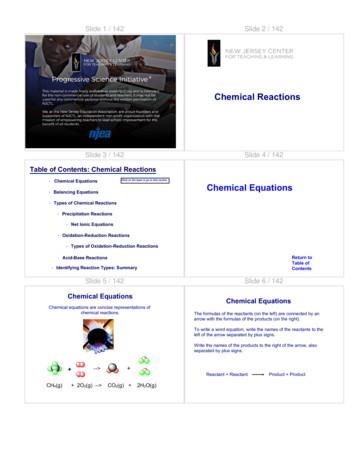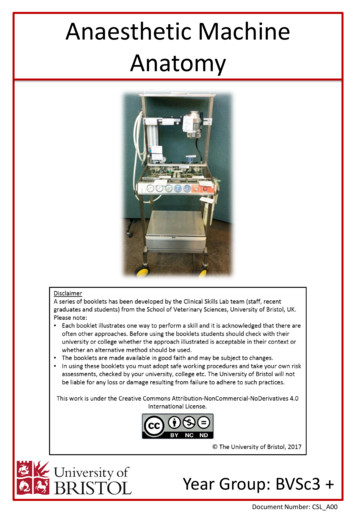Chemical Reactions And Enzymes Notes PPT - Enfield High
Lesson OverviewChemical Reactions and EnzymesChemicalReactions andEnzymes
Lesson OverviewChemical Reactions and EnzymesChemical ReactionsA chemical reaction is a process that changes, or transforms,one set of chemicals into another by changing the chemicalbonds that join atoms in compounds
Lesson OverviewChemical Reactions and EnzymesChemical ReactionsA chemical reaction is a process that changes, or transforms,one set of chemicals into another by changing the chemicalbonds that join atoms in compounds Bonds can either be created or brokenThe melting of ice is NOT a chemical reaction because newchemicals are not formed (the bonds between hydrogenand oxygen are not changed)
Lesson OverviewChemical Reactions and EnzymesChemical ReactionsA chemical reaction is a process that changes, or transforms,one set of chemicals into another by changing the chemicalbonds that join atoms in compounds Bonds can either be created or brokenThe melting of ice is NOT a chemical reaction because newchemicals are not formed (the bonds between hydrogenand oxygen are not changed) During chemical reactions, both mass and energy areconserved
Lesson OverviewChemical Reactions and EnzymesChemical Reactions The elements or compounds that enter into a chemicalreaction are known as reactants
Lesson OverviewChemical Reactions and EnzymesChemical Reactions The elements or compounds that enter into a chemicalreaction are known as reactants The elements or compounds produced by a chemicalreaction are known as products
Lesson OverviewChemical Reactions and EnzymesChemical Reactions The elements or compounds that enter into a chemicalreaction are known as reactants The elements or compounds produced by a chemicalreaction are known as products Example 2 Na 2 HCl 2 NaCl H2REACTANTSPRODUCTS
Lesson OverviewChemical Reactions and EnzymesChemical ReactionsA chemical reaction in the bloodstream As it enters the blood, carbon dioxide reacts with waterto produce carbonic acid (H2CO3), which is highlysoluble
Lesson OverviewChemical Reactions and EnzymesChemical ReactionsA chemical reaction in the bloodstream This reaction enables the blood to carry carbon dioxideto the lungs
Lesson OverviewChemical Reactions and EnzymesChemical ReactionsA chemical reaction in the bloodstream In the lungs, the reaction is reversed and producescarbon dioxide gas, which you exhale
Lesson OverviewChemical Reactions and EnzymesEnergy in ReactionsChemical reactions involve changes in energy
Lesson OverviewChemical Reactions and EnzymesEnergy in ReactionsChemical reactions involve changes in energy Some chemical reactions, called exothermic reactions,release energy
Lesson OverviewChemical Reactions and EnzymesEnergy in ReactionsChemical reactions involve changes in energy Some chemical reactions, called exothermic reactions,release energy Other reactions, called endothermic reactions, absorbenergy
Lesson OverviewChemical Reactions and EnzymesEnergy in ReactionsThe energy needed to get a reaction started is calledactivation energy
Lesson OverviewChemical Reactions and EnzymesEnergy in ReactionsThe energy needed to get a reaction started is calledactivation energy Activation energy is the difference between the requiredenergy and the energy of the reactants
Lesson OverviewChemical Reactions and EnzymesEnergy in ReactionsEnergy-releasing (exothermic) reactions have more energy inthe reactants than in the products
Lesson OverviewChemical Reactions and EnzymesEnergy in ReactionsEnergy-releasing (exothermic) reactions have more energy inthe reactants than in the productsActivationEnergyReactantsProducts
Lesson OverviewChemical Reactions and EnzymesEnergy in ReactionsEnergy-absorbing (endothermic) reactions have less energy inthe reactants than in the products
Lesson OverviewChemical Reactions and EnzymesEnergy in ReactionsEnergy-absorbing (endothermic) reactions have less energy inthe reactants than in the productsProductsActivation EnergyReactants
Lesson OverviewChemical Reactions and EnzymesEnergy in ReactionsAn example in living things An example of an energy-releasing reaction is thebreakdown of ATP to form ADP and a phosphate group
Lesson OverviewChemical Reactions and EnzymesEnergy in ReactionsAn example in living things An example of an energy-releasing reaction is thebreakdown of ATP to form ADP and a phosphate group An example of an energy-absorbing reaction is thesynthesis of ATP from ADP and a phosphate group
Lesson OverviewChemical Reactions and EnzymesEnzymesA catalyst is a substance that speeds up the rate of achemical reaction
Lesson OverviewChemical Reactions and EnzymesEnzymesA catalyst is a substance that speeds up the rate of achemical reaction Catalysts work by lowering the activation energyCatalysts are important because some reactions that makelife possible are too slow or have activation energies thatare too high
Lesson OverviewChemical Reactions and EnzymesEnzymesEnzymes are proteins that act as biological catalysts
Lesson OverviewChemical Reactions and EnzymesEnzymesEnzymes are proteins that act as biological catalysts Enzymes speed up chemical reactions that take place incells by lowering the activation energy of the reaction
Lesson OverviewChemical Reactions and EnzymesEnzymesEnzymes provide a site where reactants can be broughttogether to reactSuch a site reduces the energy needed for reaction
Lesson OverviewChemical Reactions and EnzymesEnzymesEnzymes provide a site where reactants can be broughttogether to reactSuch a site reduces the energy needed for reaction The reactants of enzyme-catalyzed reactions are knownas substrates
Lesson OverviewChemical Reactions and EnzymesEnzymesAn enzyme-catalyzed reaction The substrates bind to theenzyme on the active site
Lesson OverviewChemical Reactions and EnzymesEnzymesAn enzyme-catalyzed reaction The substrates bind to theenzyme on the active site The substrates areconverted into products
Lesson OverviewChemical Reactions and EnzymesEnzymesAn enzyme-catalyzed reaction The substrates bind to theenzyme on the active site The substrates areconverted into products The products are released
Lesson OverviewChemical Reactions and EnzymesEnzymesAn enzyme-catalyzed reaction The substrates bind to theenzyme on the active site The substrates areconverted into products The products are released The enzyme is ready foranother reaction
Lesson OverviewChemical Reactions and EnzymesEnzymesThe active site and the substrates have complementaryshapesThe fit is very precise, much like a lock that can only beopened by one key
Lesson OverviewChemical Reactions and EnzymesEnzymesBecause enzymes are catalysts for chemical reactions, theycan be affected by any variable that influences a chemicalreaction
Lesson OverviewChemical Reactions and EnzymesEnzymesBecause enzymes are catalysts for chemical reactions, theycan be affected by any variable that influences a chemicalreaction Many enzymes are affected by changes in temperatureEnzymes work best at certain temperaturesEnzymes produced by human cells generally work best attemperatures close to 37 degrees Celsius, the normaltemperature of the human body
Lesson OverviewChemical Reactions and EnzymesEnzymesBecause enzymes are catalysts for chemical reactions, theycan be affected by any variable that influences a chemicalreaction Enzymes work best at certain pH valuesFor example, the stomach enzyme pepsin, which beginsprotein digestion, works best under acidic conditions.
Lesson OverviewChemical Reactions and EnzymesEnzymesBecause enzymes are catalysts for chemical reactions, theycan be affected by any variable that influences a chemicalreaction The activities of most enzymes are regulated bymolecules that carry chemical signals within cells,switching enzymes “on” or “off” as needed
Lesson Overview Chemical Reactions and Enzymes Chemical Reactions and Enzymes. Lesson Overview Chemical Reactions and Enzymes Chemical Reactions A chemical reaction is a process that changes , or transforms, one set of chemicals into another by changing the
Chemical Reactions Slide 3 / 142 Table of Contents: Chemical Reactions · Balancing Equations Click on the topic to go to that section · Types of Chemical Reactions · Oxidation-Reduction Reactions · Chemical Equations · Net Ionic Equations · Types of Oxidation-Reduction Reactions · Acid-Base Reactions · Precipitation Reactions
metabolism? We can group enzymes together according to the types of reactions they catalyse. –Hydrolase enzymes control hydrolysis reactions. –Oxidoreductase enzymes control redox reactions. –Transferase enzymes move whole chemical groups (eg. methyl, amino, carboxyl). –Isomerase enzymes change the shape of a molecule (creating an .
4 CHARACTERISTICS of Enzymes – 1. Enzymes do not make anything happen that couldn’t happen on its own, just makes it happen faster. 2. Enzymes are not used up in reactions. They can be used over and over again! 3. Enzymes are highly specific: each enzyme catalyzes a specific chemical rea
Catalysts are substances that speed up chemical reactions. Enzymes are protein catalysts for chemical reactions in biological systems. Most chemical reactions of living cells would occur very slowly if they were not catalyzed by enzymes. By contrast to non-protein catalysts, each enzyme catalyses a small number of reactions, frequently only one.
Restriction enzymes and DNA ligases represent the cutting and joining functions in DNA manipulation. All other enzymes involved in genetic engineering fall under the broad category of enzymes known as DNA modifying enzymes. These enzymes are involved in the degradation, synthesis and alteration of the nucle
Chemical reactions called _ reactions give off heat. 5. Other reactions called _ reactions absorb heat and cool the immediate environment. 6. True or False. During all chemical reactions, a chemical change takes place that produces new substances with properties different than those of the original substances. .
2. Enzymes accelerate the rates of reactions relative to non-enzyme catalyzed reactions by factors of 106 to 1015 . 4. Enzymes catalyze a limited repertoire of reactions compared to the number of reactions that . opinion in
Anaesthetic Machine Anatomy O 2 flow-meter N 2 O flow-meter Link 22. Clinical Skills: 27 28 Vaporisers: This is situated on the back bar of the anaesthetic machine downstream of the flowmeter It contains the volatile liquid anaesthetic agent (e.g. isoflurane, sevoflurane). Gas is passed from the flowmeter through the vaporiser. The gas picks up vapour from the vaporiser to deliver to the .























